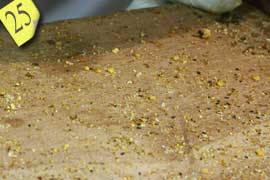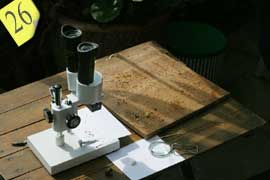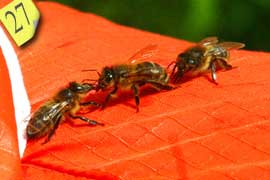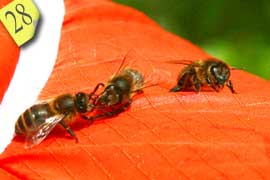
 |
HOME |
An Apiarist's Bees
PART FIVE |
||||
 Beneath mesh at the base of the hive is a board which catches any debris falling from the boxes above. Apiarists examine the debris for any sign of problems. The yellow specks seen here are pollen, and the white is wax debris. |
 Once under the microscope this visit to the hive unearthed a Varroa mite. The size of a pinhead this eight-legged mite hides where the bees lay the eggs and then feeds on the developing larvae resulting in deformities, weak adults and mortality. A major infestation can severely undermine a hive's chances of survival. GO TO VARROA PICTURE |
||||
 Bees have an incredibly complex ability for communication. The queen controls the activity of the whole hive through the excretion of pheromones and the workers (as seen here on Don's bee suit) will adjust their activities according to her instructions. |
 Bees perform dances upon returning to the hive following combinations of circular, zig-zagging and waggle patterns. This activity communicates the distance and direction of food sources to other bees in the hive. Other theorists say that the dance attracts other workers to investigate the incoming bee for nectar odours. |
||||
|
The editor was invited to attend a meeting of the Meon Valley Bee Keeper's Association in Hampshire. Many thanks to Don Burgess and Bill Oakford for their invitation and informative instruction. Also to Astra Pakenham-Walsh and Stephen Tompsett for access to their hives and for their superb hospitality. Photography and words by Phil Kemp |
WANT TO FIND OUT MORE More about bees on the Wey River site Meon Valley Bee Keeper's Association |
||||
| Suggest a topic for another Wey River photo-essay |
|||||